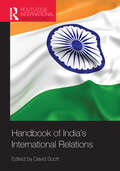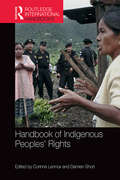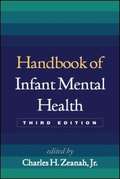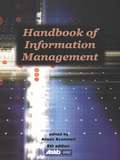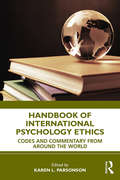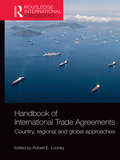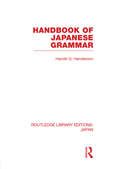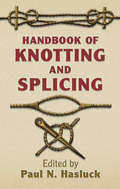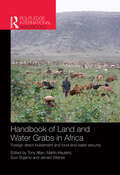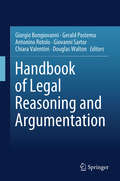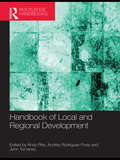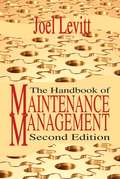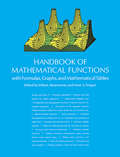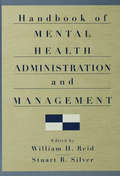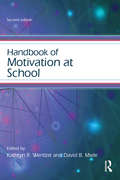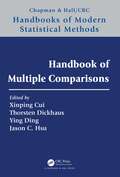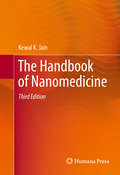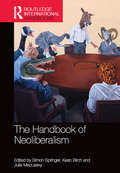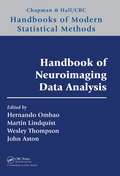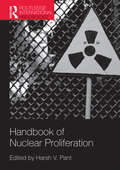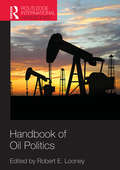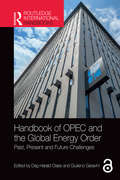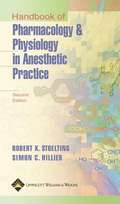- Table View
- List View
Handbook of Inclusive Education
by Central Board Of Secondary EducationThe Constitution of India emphasizes the importance of equality of status and opportunity for all citizens, and institutions like CBSE have a duty to support and inspire every child to succeed. In order to promote inclusivity in schools and ensure that children with special needs are accommodated, CBSE has made it mandatory for schools to provide disability-specific learning aids, alternate pedagogies, and exam concessions. To disseminate accurate information on these provisions, CBSE has created a handbook for teachers that provides guidance on identifying children with special needs, creating a barrier-free environment, using instructional designs and assistive technologies, and conducting assessments. While the handbook follows a generic approach, it can be adapted to suit the needs of different contexts and target groups. CBSE believes that the tools and techniques outlined in the handbook will be useful for teachers and will increase access, equity, and participation of all children in the learning process.
Handbook of India's International Relations
by David ScottThis Handbook gives an overview of India’s international relations, given the development of India as a major economic power in the world, and the growing interest in the impact of Asia on the international system in the future. Edited by David Scott of Brunel University, and with chapters written by a variety of experts, the Handbook of India’s International Relations offers an up-to-date, unbiased and comprehensive resource to academics, students of international relations, business people, media professionals and the general reader.There is a pre-publication price on this title, the price rises to £150 three months after publication.
Handbook of Indigenous Peoples' Rights (Routledge International Handbooks Ser.)
by Corinne Lennox Damien ShortThis handbook will be a comprehensive interdisciplinary overview of indigenous peoples’ rights. Chapters by experts in the field will examine legal, philosophical, sociological and political issues, addressing a wide range of themes at the heart of debates on the rights of indigenous peoples. The book will address not only the major questions, such as ‘who are indigenous peoples? What is distinctive about their rights? How are their rights constructed and protected? What is the relationship between national indigenous rights regimes and international norms? but also themes such as culture, identity, genocide, globalization and development, rights institutionalization and the environment.
Handbook of Infant Mental Health
by Charles H. ZeanahWidely regarded as the standard reference in the field, this state-of-the-art Handbook offers a comprehensive analysis of developmental, clinical, and social aspects of mental health from birth to the preschool years. Leading authorities explore models of development; biological, family, and sociocultural risk and protective factors; and frequently encountered disorders and disabilities. Evidence-based approaches to assessment and treatment are presented, with an emphasis on ways to support strong parent-child relationships. The volume reviews the well-documented benefits of early intervention and prevention and describes applications in mental health, primary care, childcare, and child welfare settings. The chapter on psychopharmacology has been updated for the paperback edition.
Handbook of Information Management
by Alison ScammellThis is effectively the eighth edition of Aslib's flagship reference work, Handbook of Special Librarianship and Information Work, which has provided the seminal text on modern information theory, practice, and procedure since 1957. Scammell draws on a substantial background of research and best practice to provide a pragmatic approach to information management in the workplace. This volume covers strategic, legal, management, and marketing issues and highlights the importance of new web-based delivery mechanisms. It includes contributions from outside the UK, mirroring the global nature of information management.Includes:* essential reference to core theories and principles of information organization, retrieval and dissemination* a new chapter exploring the legal issues involved with information on the Internet* new topics including: freedom of information, project management, digital library research, the hybrid library, the effective website and the intranet.
Handbook of International Psychology Ethics: Codes and Commentary from Around the World
by Karen L. ParsonsonThe Handbook of International Psychology Ethics discusses the most central, guiding principles of practice for mental health professionals around the world. For researchers, practicing mental health professionals, and students alike, the book provides a window into the values and belief systems of cultures worldwide. Chapters cover ethics codes from psychological associations and societies on five continents, translating each code into English and discussing vital questions around how the code is put into practice, what it means to association members and society at large, as well as how the code was developed within its unique historical, political, and cultural context.
Handbook of International Trade Agreements: Country, regional and global approaches (Routledge International Handbooks)
by Robert E. LooneyInternational trade has, for decades, been central to economic growth and improved standards of living for nations and regions worldwide. For most of the advanced countries, trade has raised standards of living, while for most emerging economies, growth did not begin until their integration into the global economy. The economic explanation is simple: international trade facilitates specialization, increased efficiency and improved productivity to an extent impossible in closed economies. However, recent years have seen a significant slowdown in global trade, and the global system has increasingly come under attack from politicians on the right and on the left. The benefits of open markets, the continuation of international co-operation, and the usefulness of multilateral institutions such as the World Trade Organization (WTO), the International Monetary Fund and the World Bank have all been called into question. While globalization has had a broadly positive effect on overall global welfare, it has also been perceived by the public as damaging communities and social classes in the industrialized world, spawning, for example, Brexit and the US exit from the Trans-Pacific Partnership. The purpose of this volume is to examine international and regional preferential trade agreements (PTAs), which offer like-minded countries a possible means to continue receiving the benefits of economic liberalization and expanded trade. What are the strengths and weaknesses of such agreements, and how can they sustain growth and prosperity for their members in an ever-challenging global economic environment? The Handbook is divided into two parts. The first, Global Themes, offers analysis of issues including the WTO, trade agreements and economic development, intellectual property rights, security and environmental issues, and PTAs and developing countries. The second part examines regional and country-specific agreements and issues, including NAFTA, CARICOM, CETA, the Pacific Alliance, the European Union, EFTA, ECOWAS, SADC, TTIP, RCEP and the TPP (now the CPTPP), as well as the policies of countries such as Japan and Australia.
Handbook of Japanese Grammar (Routledge Library Editions: Japan)
by Harold G HendersonThis grammar has been written to help the student to think in the Japanese way. Part One contains several introductory notes on Nomenclature, Syntax, Verbs, Aru, Iru, Oru, on Adjectives and on Foreign Words. Part Two concentrates on connectives – the particles and suffixes which modify the sense of other words or show the relationship of these words to each other. These connectives, the heart of Japanese grammar, present unusual difficulty to foreign students. Arranged alphabetically in dictionary form, each word is followed by a textual explanation of how it is used and of its various meanings, with cautions as to its translation. The forms covered include not only those of the "standard" colloquial literary or bungo styles, but also the more common colloquialisms and provincial forms, whether or not these are strictly grammatical. No other text available makes as through or as complete a classification.
Handbook of Knotting and Splicing (Dover Maritime Series)
by Paul N. HasluckGenerations of scouts and sailors have learned their lore from this classic reference by a master craftsman. Editor Paul N. Hasluck was a renowned contributor to numerous technical journals as well as the author of several books on crafts and antiques. His clearly written guide--amply illustrated with 208 figures--dates from the turn of the twentieth century and offers timeless instruction for knotters and splicers of ropes.Starting with simple and useful knots, this manual proceeds to more complex varieties: eye knots, hitches, and bends; ring knots and rope shortenings; ties and lashings; and fancy knots. Additional topics include rope splicing; working cordage; hammock making; lashings and ties for scaffolding; and splicing and socketing wire ropes. A helpful index appears at the end, and a list of illustrations identifies the figures in order of appearance.
Handbook of Land and Water Grabs in Africa: Foreign direct investment and food and water security (Routledge International Handbooks Ser.)
by Tony Allan Jeroen Warner Martin Keulertz Suvi SojamoAccording to estimates by the International Land Coalition based at the International Fund for Agricultural Development (IFAD), 57 million hectares of land have been leased to foreign investors since 2007. Current research has focused on human rights issues related to inward investment in land but has been ignorant of water resource issues and the challenges of managing scarce water. This handbook will be the first to address inward investment in land and its impact on water resources in Africa. The geographical scope of this book will be the African continent, where land has attracted the attention of risk-taking investors because much land is under-utilised marginalized land, with associated water resources and rapidly growing domestic food markets. The successful implementation of investment strategies in African agriculture could determine the future of more than one billion people. An important factor to note is that Sub-Saharan Africa will, of all the continents, be hit hardest by climate change, population growth and food insecurity. Sensible investment in agriculture is therefore needed, however, at what costs and at whose expense? The book will also address the livelihoods theme and provide a holistic analysis of land and water grabbing in Sub-Saharan Africa. Four other themes will addressed: politics, economics, environment and the history of land investments in Sub-Saharan Africa. The editors have involved a highly diverse group of around 25 expert researchers, who will review the pro and anti-investment arguments, geopolitics, the role of capitalist investors, the environmental contexts and the political implications of, and reasons for, leasing millions of hectares in Sub-Saharan Africa. To date, there has been no attempt to review land investments through a suite of different lenses, thus this handbook will differ significantly from existing research and publication. The editors are Tony Allan, (Professor Emeritus, Department of Geography, School of Oriental and African Studies and King’s College London); Jeroen Warner (Assistant Professor, Disaster Studies, University of Wageningen); Suvi Sojamo (PhD Researcher, Water and Development Research Group, Aalto University); and Martin Keulertz (PhD Researcher, Department of Geography, London Water Group, King’s College London).
Handbook of Legal Reasoning and Argumentation
by Giorgio Bongiovanni Gerald Postema Antonino Rotolo Giovanni Sartor Chiara Valentini Douglas WaltonThis handbook addresses legal reasoning and argumentation from a logical, philosophical and legal perspective. The main forms of legal reasoning and argumentation are covered in an exhaustive and critical fashion, and are analysed in connection with more general types (and problems) of reasoning. Accordingly, the subject matter of the handbook divides in three parts. The first one introduces and discusses the basic concepts of practical reasoning. The second one discusses the general structures and procedures of reasoning and argumentation that are relevant to legal discourse. The third one looks at their instantiations and developments of these aspects of argumentation as they are put to work in the law, in different areas and applications of legal reasoning.
Handbook of Local and Regional Development
by Andy PikeThe Handbook of Local and Regional Development provides a comprehensive statement and reference point for local and regional development. The scope of this Handbook’s coverage and contributions engages with and reflects upon the politics and policy of how we think about and practise local and regional development, encouraging dialogue across the disciplinary barriers between notions of ‘local and regional development’ in the Global North and ‘development studies’ in the Global South. This Handbook is organized into seven inter-related sections, with an introductory chapter setting out the rationale, aims and structure of the Handbook. Section one situates local and regional development in its global context. Section two establishes the key issues in understanding the principles and values that help us define what is meant by local and regional development. Section three critically reviews the current diversity and variety of conceptual and theoretical approaches to local and regional development. Section four address questions of government and governance. Section five connects critically with the array of contemporary approaches to local and regional development policy. Section six is an explicitly global review of perspectives on local and regional development from Africa, Asia-Pacific, Europe, Latin America and North America. Section seven provides reflection and discussion of the futures for local and regional development in an international and multidisciplinary context. With over forty contributions from leading international scholars in the field, this Handbook provides critical reviews and appraisals of current state-of-the-art conceptual and theoretical approaches and future developments in local and regional development.
The Handbook of Maintenance Management
by Joel LevittNow in its second edition and written by a highly acclaimed maintenance professional, this comprehensive and easy-to-understand resource provides a short review of all the major discussions going on in the management of the maintenance function. This revision of a classic has been thoroughly updated to include advances in technology and thinking and is sure to be found useful by maintenance professionals everywhere. It's the perfect reference for any maintenance professional that needs a quick update on any specific area within the subject.
Handbook of Mathematical Functions: with Formulas, Graphs, and Mathematical Tables
by Milton Abramowitz Irene A. StegunDespite the increasing use of computers, the basic need for mathematical tables continues. Tables serve a vital role in preliminary surveys of problems before programming for machine operation, and they are indispensable to thousands of engineers and scientists without access to machines. Because of automatic computers, however, and because of recent scientific advances, a greater variety of functions and a higher accuracy of tabulation than have been available until now are required.In 1954, a conference on mathematical tables, sponsored by M.I.T. and the National Science Foundation, met to discuss a modernization and extension of Jahnke and Emde's classical tables of functions. This volume, published 10 years later by the U.S. Department of Commerce, is the result. Designed to include a maximum of information and to meet the needs of scientists in all fields, it is a monumental piece of work, a comprehensive and self-contained summary of the mathematical functions that arise in physical and engineering problems.The book contains 29 sets of tables, some to as high as 20 places: mathematical constants; physical constants and conversion factors (6 tables); exponential integral and related functions (7); error function and Fresnel integrals (12); Bessel functions of integer (12) and fractional (13) order; integrals of Bessel functions (2); Struve and related functions (2); confluent hypergeometric functions (2); Coulomb wave functions (2); hypergeometric functions; Jacobian elliptic and theta functions (2); elliptic integrals {9); Weierstrass elliptic and related functions; parabolic cylinder functions {3); Mathieu functions (2); spheroidal wave functions (5); orthogonal polynomials (13); combinatorial analysis (9); numerical interpolation, differentiation and integration (11); probability functions (ll); scales of notation (6); miscellaneous functions (9); Laplace transforms (2); and others.Each of these sections is prefaced by a list of related formulas and graphs: differential equations, series expansions, special functions, and other basic relations. These constitute an unusually valuable reference work in themselves. The prefatory material also includes an explanation of the numerical methods involved in using the tables that follow and a bibliography. Numerical examples illustrate the use of each table and explain the computation of function values which lie outside its range, while the editors' introduction describes higher-order interpolation procedures. Well over100 figures illustrate the text.In all, this is one of the most ambitious and useful books of its type ever published, an essential aid in all scientific and engineering research, problem solving, experimentation and field work. This low-cost edition contains every page of the original government publication.
Handbook of Mental Health Administration and Management
by William H. Reid Mph Stuart B. SilverClinicians who understand mental health care administration in addition to their clinical fields are likely to be valuable to the organizations in which they work. This handbook is an accessible source of information for professionals coming from either clinical or management backgrounds. Sections offer coverage in: mental health administrative principles, mental health care management, business, finance and funding of care, information technology, human resources and legal issues.
Handbook of Motivation at School (Educational Psychology Handbook)
by Edited by Kathryn R. Wentzel and David B. MieleThe second edition of the Handbook of Motivation at School presents an integrated compilation of theory and research in the field. With chapters by leading experts, this book covers the major theoretical perspectives in the field as well as their application to instruction, learning, and social adjustment at school. Section I focuses on theoretical perspectives and major constructs, Section II on contextual and social influences on motivation, and Section III on new directions in the field. This new edition will have the same popular organizational structure with theories at the beginning. It will also include new chapters that cover motivation as it relates to identity, culture, test anxiety, mindfulness, neuroscience, parenting, metacognition, and regulatory focus.
Handbook of Multiple Comparisons (Chapman & Hall/CRC Handbooks of Modern Statistical Methods)
by Xinping Cui, Thorsten Dickhaus, Ying Ding, Jason C. HsuWritten by experts that include originators of some key ideas, chapters in the Handbook of Multiple Testing cover multiple comparison problems big and small, with guidance toward error rate control and insights on how principles developed earlier can be applied to current and emerging problems. Some highlights of the coverages are as follows. Error rate control is useful for controlling the incorrect decision rate. Chapter 1 introduces Tukey's original multiple comparison error rates and point to how they have been applied and adapted to modern multiple comparison problems as discussed in the later chapters. Principles endure. While the closed testing principle is more familiar, Chapter 4 shows the partitioning principle can derive confidence sets for multiple tests, which may become important as the profession goes beyond making decisions based on p-values. Multiple comparisons of treatment efficacy often involve multiple doses and endpoints. Chapter 12 on multiple endpoints explains how different choices of endpoint types lead to different multiplicity adjustment strategies, while Chapter 11 on the MCP-Mod approach is particularly useful for dose-finding. To assess efficacy in clinical trials with multiple doses and multiple endpoints, the reader can see the traditional approach in Chapter 2, the Graphical approach in Chapter 5, and the multivariate approach in Chapter 3. Personalized/precision medicine based on targeted therapies, already a reality, naturally leads to analysis of efficacy in subgroups. Chapter 13 draws attention to subtle logical issues in inferences on subgroups and their mixtures, with a principled solution that resolves these issues. This chapter has implication toward meeting the ICHE9R1 Estimands requirement. Besides the mere multiple testing methodology itself, the handbook also covers related topics like the statistical task of model selection in Chapter 7 or the estimation of the proportion of true null hypotheses (or, in other words, the signal prevalence) in Chapter 8. It also contains decision-theoretic considerations regarding the admissibility of multiple tests in Chapter 6. The issue of selected inference is addressed in Chapter 9. Comparison of responses can involve millions of voxels in medical imaging or SNPs in genome-wide association studies (GWAS). Chapter 14 and Chapter 15 provide state of the art methods for large scale simultaneous inference in these settings.
The Handbook of Nanomedicine
by Kewal K. JainNanomedicine is clinical medicine with the application of nanobiotechnology, which is currently being used to research the pathomechanism of disease, refine molecular diagnostics, and aid in the discovery, development and delivery of drugs. In The Handbook of Nanomedicine, Prof. Kewal K. Jain distills the voluminous literature relevant to the subject into one concise, comprehensive and easy-to-use guide. Beginning with the basics, the subject is developed to potential clinical applications, many of which are still at an experimental stage. Important components of nanomedicine such as nanodiagnostics and nanopharmaceuticals are covered extensively. As this text is aimed at nonmedical scientists, pharmaceutical personnel, as well as physicians, descriptions of the technology involved and other medical terminology are kept as clear and simple as possible. In depth and cutting-edge, The Handbook of Nanomedicine informs its readers of the ever-growing field of nanomedicine, destined to play a significant role in the future of healthcare.
A Handbook of Native American Herbs: The Pocket Guide to 125 Medicinal Plants and Their Uses
by Alma R. HutchensThis authoritative guide--based on the author's classic reference work, Indian Herbalogy of North America--is a portable illustrated companion for the professional and amateur herbalist alike. It provides detailed descriptions of 125 of the most useful medicinal plants commonly found in North America, along with directions for a range of uses, remedies for common ailments, and notes on the herbal traditions of other lands. Entries include staples of folk medicine such as echinacea and slippery elm as well as common kitchen herbs--such as parsley, thyme, and pepper--whose tonic and healing properties are less widely known.
Handbook of Neoliberalism
by Simon Springer Kean Birch Julie MacLeavyNeoliberalism is easily one of the most powerful discourses toemerge within the social sciences in the last two decades, and the number of scholars who write about this dynamic and unfolding process of socio-spatial transformation isastonishing. Even more surprising though is that there has, until now, not been an attempt to provide a wide-ranging volume that engages with the multiple registers in which neoliberalism has evolved. The Routledge Handbook of Neoliberalism seeks to offer a comprehensive overview of the phenomenon of neoliberalism by examining the range of ways that it has been theorized, promoted, critiqued, and put into practice in a variety of geographical locations and institutional frameworks. With contributions from over 50 leadingauthors working at institutions around the world the volumes seven sections will offer a systematic overview of neoliberalism’s origins, political implications, social tensions, spaces, natures and environments, and aftermaths in addressing ongoing and emerging debates. The volume aims to provide the first comprehensive overview of the field and to advance the established and emergent debates in a field that has grown exponentially over the past two decades, coinciding with the meteoric rise of neoliberalism as a hegemonic ideology, state form, policy and program, and governmentality. It includes a substantive introductory chapter and will serve as an invaluable resource for undergraduates, graduate students, and professional scholars alike.
Handbook of Neuroimaging Data Analysis (Chapman & Hall/CRC Handbooks of Modern Statistical Methods)
by Hernando Ombao Martin Lindquist Wesley Thompson John AstonThis book explores various state-of-the-art aspects behind the statistical analysis of neuroimaging data. It examines the development of novel statistical approaches to model brain data. Designed for researchers in statistics, biostatistics, computer science, cognitive science, computer engineering, biomedical engineering, applied mathematics, physics, and radiology, the book can also be used as a textbook for graduate-level courses in statistics and biostatistics or as a self-study reference for Ph.D. students in statistics, biostatistics, psychology, neuroscience, and computer science.
Handbook of Nuclear Proliferation (Routledge International Handbooks Ser.)
by Harsh V. PantThe chapters of this proposed volume are intended to shed light on the diverse themes surrounding this very important issue area in international security. Each of the six major sections addresses an aspect of nuclear proliferation that will be critical in determining the future trajectory of global politics in the years to come. The first section examines the major thematic issues underlying the contemporary discourse on nuclear proliferation. How do we understand this period in proliferation? What accounts for a taboo on the use of nuclear weapons so far and will it survive? What is the present state of nuclear deterrence models built during the Cold War? What is the relationship between the pursuit of civilian nuclear energy and the risks of proliferation? Why are we witnessing a move away from non-proliferation to counter-proliferation? The second section gives an overview of the evolving nuclear policies of the five established nuclear powers: the USA, Russia, the United Kingdom, France and the People's Republic of China. Section three looks at the three de facto nuclear states: India, Pakistan and Israel. The fourth section examines the three problem areas in the proliferation matrix today – Iran, North Korea and the potent mix of non-state actors and nuclear weapons. The fifth section sheds light on an important issue often ignored during discussions of nuclear proliferation – cases where states have made a deliberate policy choice of either renouncing their nuclear weapons programme, or have decided to remain a threshold state. The cases of South Africa, Egypt and Japan will be the focus of this section. The final section will examine the present state of the global nuclear non-proliferation regime, which most observers agree is currently facing a crisis of credibility. The three pillars of this regime – the Nuclear Non-Proliferation Treaty (NPT), the Comprehensive Test Ban Treaty (CTBT), and the Fissile Material Cut-Off Treaty (FMCT) – will be examined. This is followed by an analysis of the present trends and prospects for US-Russia nuclear arms control. The impact of missile defenses and the US-India civilian nuclear energy co-operation pact will be examined so as to ascertain whether they have weakened or strengthened the global non-proliferation regime. The chapters in this volume aim to document the increasing complexity of the global nuclear proliferation dynamic and the inability of the international community to come to terms with a rapidly changing strategic milieu. The future, in all likelihood, will be very different from the past, and the chapters in this volume will try to develop a framework that may help gain a better understanding of the forces that will shape the nuclear proliferation debate in the years to come. Proposed Contents Introduction – Overview Part 1: Thematic Issues The Second Nuclear Age The Nuclear Taboo Nuclear Deterrence Nuclear Energy and Non-Proliferation Non-Proliferation and Counter Proliferation Non-State Actors and Nuclear Weapons Part 2: The Five Nuclear Powers USA Russia United Kingdom France People's Republic of China Part 3: De Facto Nuclear States India Pakistan Israel Part 4: The ‘Problem’ States Iran North Korea Part 5: The ‘Threshold’ States South Africa Japan Egypt Part 6: The Global Non-Proliferation Regime The NPT The CTBT The FMCT US-Russia Nuclear Arms Control The Impact of Missile Defenses The US-India Nuclear Deal The Future: What It May Hold In Store Conclusion
Handbook of Oil Politics (Routledge International Handbooks Ser.)
by Robert E. LooneyThese days, one would have a difficult time picking up a newspaper, or watching a newscast that did not have a lead story dealing with some aspect of oil. From instability in the Middle East, to stock market crashes and concerns over the health of the world economy, to wars that seem to break out unexpectedly around the world, to discussions of global warming, and even speculation over the fate of mankind, oil is usually lurking somewhere in the background. To many, oil markets and their linkages to a whole spectrum of events remain something of a mystery. Unfortunately, most of the easily obtained information on oil is deeply flawed. Whole web-conspiracy sites depict ruthless insiders and reckless dictators manipulating energy markets at will. The 30 essays in this volume, written by the leading experts in the field, attempt to set the record straight. While their assessments may lack the sensationalism of many popular pundits, serious readers will find their insights invaluable in the years to come in providing a framework for understanding many of the events of the day. The volume is divided into sections. Part I provides a broad overview of the political dimensions underlying the supply of oil. Some of the key questions addressed include: is the world running out of oil? And if so, is the cause physical scarcity or political/policy failure? Why are many of the oil-producing countries in the developing world so unstable? Can oil markets be made to provide more stability to the world system? Part II examines some of the political responses to oil-related developments. Here, the key questions concern the role of the political process in the development of alternative sources of energy. The various means through which countries approach their energy security is assessed, as is the problem of climate change. The section ends with the provocative question, do governments really need to go to war for oil? Oil production, energy markets, and the political environment produce distinct regional patterns. Part III examines oil and political power in Africa, Latin America, the Middle East and South-East Asia. Part IV expands some of the main regional themes through a series of case studies on specific countries: Iraq, Iran, Saudi Arabia, Egypt, Russia and Brazil. A final section looks to the future: will the oil curse continue for many countries? How will the growth and expansion of China affect oil prices and availabilities? Will oil-based sovereign wealth funds contribute to global stability or will they create increased political tensions between consuming and producing countries? Will volatile oil markets undermine the US dollar as well as the global financial system? Perhaps appropriately, the volume ends with an assessment of the future of oil in a carbon constrained world. All in all, the essays in this volume cover the whole spectrum of the politics of oil. Hopefully they will help shed light on this vital, yet still often misunderstood topic. The book does not represent any particular political or ideological position. Instead, each author has sought to objectively seek a deeper understanding as to the complexity and subtlety of forces that have all too often eluded policymakers around the world.
Handbook of OPEC and the Global Energy Order: Past, Present and Future Challenges (Routledge International Handbooks)
by Dag Harald Claes Giuliano GaraviniThe Organization of the Petroleum Exporting Countries (OPEC), celebrating its 60th anniversary in 2020, is one of the most recognizable acronyms in international politics. The organization has undergone decades of changing importance, from political irrelevance to the spotlight of world attention and back; and from economic boom for its members to deep political and financial crisis. This handbook, with chapters provided by scholars and analysts from different backgrounds and specializations, discusses and analyzes the history and development of OPEC, its global importance, and the role it has played, and still plays, in the global energy market. Part I focuses on the relationship between OPEC and its member states. Part II examines the relationship between OPEC and its customers, the consuming countries and their governments, while Part III addresses the relationship between OPEC and its competitors and potential partners, the non-OPEC producers, and the international oil companies. The final section, Part IV, looks at OPEC and the governance of international energy.
Handbook of Pharmacology and Physiology in Anesthetic Practice
by Robert K. Stoelting Simon C. HillierDesigned for quick reference in the operating room or rapid review for board exams, this handbook presents the most critical clinical information from the newly updated Fourth Edition of Pharmacology and Physiology in Anesthetic Practice.

